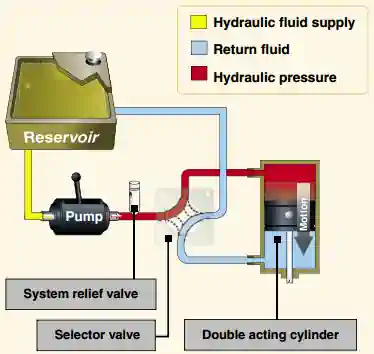Hydraulics & Pneumatics
Hydraulic and pneumatic systems assist flight and auxiliary systems, especially in complex aircraft requiring larger forces.
Hydraulics & Pneumatics Introduction
- Hydraulics provide mechanical advantage to system components.
- There are multiple applications for hydraulic use in aircraft, depending on the complexity of the aircraft.
Hydraulic Systems
- Hydraulics is often used on small airplanes to operate:
- On large airplanes, hydraulics is used for:
- Flight control surfaces
- Wing flaps, spoilers
- And other systems...
Hydraulics System Components
- A basic hydraulic system consists of: [Figure 1]
-
Hydraulic Reservoir:
- A mineral-based hydraulic fluid is the most widely used type for small aircraft.
- This type of hydraulic fluid, a kerosene-like petroleum product, has good lubricating properties, as well as additives to inhibit foaming and prevent the formation of corrosion.
- It is chemically stable, has very little viscosity change with temperature, and is dyed for identification.
- Since several types of hydraulic fluids are commonly used, an aircraft must be serviced with the type specified by the manufacturer.
-
Hydraulic Pumps:
- Hydraulic pumps may be either hand, electric, or engine-driven.
- The hydraulic fluid is pumped through the system to an actuator or servo.
-
Hydraulic Filters:
- Filters are necessary to keep the fluid clean.
-
Hydraulic Servos:
- A servo is a cylinder with a piston inside that turns fluid power into work and creates the power needed to actuate an aircraft system.
- Servos can be either single-acting or double-acting, based on the needs of the system.
- Therefore fluid can be applied to one (single-acting) or both sides (double-acting) of the servo, depending on the servo type.
- A single-acting servo provides power in one direction while a double-acting can provide power in both directions.
-
Hydraulic Selector Valves:
- The selector valve allows the fluid direction to be controlled.
- This is necessary for operations such as the extension and retraction of landing gear during which the fluid must work in two different directions.
-
Hydraulic Relief Valves:
- The relief valve provides an outlet for the system in the event of excessive fluid pressure in the system.
- Forces exert equal pressure on system
- Input smaller than output increases force
- Pumps provide system pressure
- Variable
- Constant: pressure regulators control pressure
- Pressure gauges provide a way to monitor the system
- Relief valves return fluid to the reservoir
- Check valves used for 1 way flow
-
Hydraulic Accumulators:
- Accumulators provide shock absorption for 1 time use
-
Hydraulic Acutators:
- Hydraulic actuators are the mechanical devices that translate hydraulic pressures into mechanical advantages
Private Pilot (Airplane) Operation of Aircraft Systems Airman Certification Standards
- Objective: To determine whether the applicant exhibits satisfactory knowledge, risk management, and skills associated with safe operation of systems on the airplane provided for the flight test.
- References: FAA-H-8083-2 (Risk Management Handbook), FAA-H-8083-3 (Airplane Flying Handbook), FAA-H-8083-23 (Seaplane, Skiplane, and Float/Ski Equipped Helicopter Operations Handbook), FAA-H-8083-25 (Pilot Handbook of Aeronautical Knowledge); POH/AFM
- Note: If K1 is selected, the evaluator must assess the applicant's knowledge of at least three sub-elements
- Private Pilot Operation of Aircraft Systems Lesson Plan
Private Pilot (Airplane) Operation of Aircraft Systems Knowledge:
The applicant demonstrates an understanding of:-
PA.I.G.K1:
Airplane systems, including:-
PA.I.G.K1a:
Primary flight controls. -
PA.I.G.K1a:
Secondary flight controls. -
PA.I.G.K1c:
Powerplant and propeller. -
PA.I.G.K1d:
Landing gear. -
PA.I.G.K1e:
Fuel, oil, and hydraulic. -
PA.I.G.K1f:
Electrical. -
PA.I.G.K1g:
Avionics. -
PA.I.G.K1h:
Pitot-static, vacuum/pressure, and associated flight instruments. -
PA.I.G.K1i:
Environmental. -
PA.I.G.K1j:
Deicing and anti-icing. -
PA.I.G.K1k:
Water Rudders (ASES, AMES). -
PA.I.G.K1l:
Oxygen Systems.
-
-
PA.I.G.K2:
Indications of and procedures for managing system abnormalities or failures.
Private Pilot (Airplane) Operation of Aircraft Systems Risk Management:
The applicant is able to identify, assess, and mitigate risks associated with:-
PA.I.G.R1:
Detection of system malfunctions or failures. -
PA.I.G.R2:
Management of a system failure. -
PA.I.G.R3:
Monitoring and management of automated systems.
Private Pilot (Airplane) Operation of Aircraft Systems Skills:
The applicant exhibits the skills to:-
PA.I.G.S1:
Operate at least three of the systems listed in K1a through K1l appropriately. -
PA.I.G.S2:
Complete the appropriate checklist(s).
Hydraulics & Pneumatics Conclusion
- Each system incorporates different components to meet the individual needs of different aircraft.
- More advanced aircraft tend to utilize higher pressurization in their system to simplify the engineering and reduce weight.
- Still looking for something? Continue searching:
